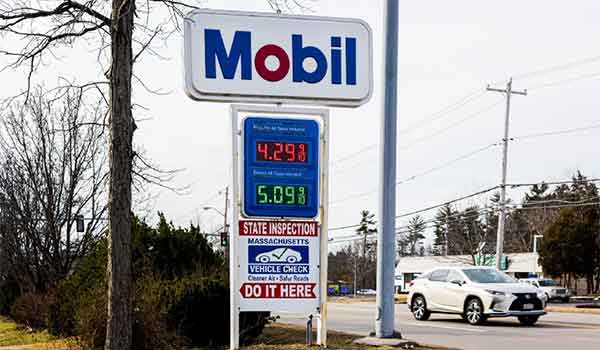By Dr. Robert Holcomb MD, Ph.D., Inventor and Co-Founder of Holcomb Energy System

By now, every mobile person on the planet has felt pain, anxiety and consternation over the dramatic increase in the price of petroleum — at its highest worldwide since 2008 — resulting in record profits for oil companies such as Shell and BP. Saudi Aramco, the petroleum and natural gas giant, has just become the most valuable company in the world, overtaking Apple with a market cap of $2.43 trillion.
This spike in fuel costs and continued worldwide reliance on oil stands in marked contrast to the terrifying findings of the UN’s latest Intergovernmental Panel on Climate Change (IPCC) report. Rather than heed the increasingly desperate calls of scientists, we live in a dystopian reality in which the oil industry is booming.
There are many underlying factors contributing to oil’s continued ubiquity, and we are going to briefly look at two: systemic processes and the impact of alternative energy sources. The complex, lengthy systemic process from oil field to gas pump is a direct contributor to rising prices. 18 percent of the cost of gasoline comes from the refining process, 12 percent from distribution and marketing, 11 percent from taxes, and 59 percent from the price of the underlying commodity itself (crude oil). If there is a minor increase in any one of these areas such as refining, it has a run-on effect along the chain, leading to painful surges in cost.

From Ugly Duckling to Swan
The journey from drilling site to gas station begins with the extraction of crude oil — the raw material from which gasoline is distilled. Within the distillery towers, oil is boiled to separate asphalt, lubricating oil, fuel oil, kerosene, diesel, gasoline, butane and petroleum. 45 percent of a barrel of oil becomes gasoline (around 19 gallons) and this process of refining contributes significantly to the cost of fuel.

The Long Road Ahead
Before arriving at the refinery, crude oil may be transported thousands of miles from its source. Oil is often drilled in isolated locations inaccessible by road or sea. Therefore, pipelines are increasingly used to transport crude oil to its transit destination before it is shipped across the world. Crude oil drilled from the Caspian Sea used to be transported to the Black Sea by rail, which added between $5–10 in costs per barrel. The Caspian Pipeline — 940 miles long installed across harsh terrain — carried a $5.5 billion construction price tag. The contribution of distribution costs to the overall price of gasoline has been significant.

Unwavering Taxes
In addition to these factors, local taxes and environmental laws play a role in ramping up fuel prices. In California, gasoline is required by law to be mixed with far more expensive ethanol. Tariffs vary widely from country to country. Italy, for example, slaps a 65% tax on gasoline. These taxes on oil companies remain relatively stable, as does the cost of refining, transporting and marketing crude oil. Therefore, while these factors contribute to the overall price of gasoline, they do not account for sporadic price spikes. Instead, the price of raw crude, often driven by political, social and market conditions, is largely responsible for the wild fluctuations in price that we see at the pump.
On the plus side, many governments worldwide offer a plethora of subsidies and financial assistance to bolster renewable energy adoption and drive down costs. In the UK for example, electric vehicle drivers are offered grants that amount to 75% of the cost of installing a domestic charging station.

Demand and a Tightly Controlled Supply
While stating that the price of gas’ underlying commodity — crude oil — is a direct result of supply and demand may be true, it is an oversimplification. Unpredictable external events can impact the availability of oil supplies, as we have unfortunately witnessed with the ongoing war in Ukraine, which has restricted access to Russian oil.
Recently, there has been an exponential shift in the adoption of renewables, as sustainable energy sources are developed and established as viable alternatives. Previously fuel consumption was relatively inflexible, so small changes in supply would result in huge changes in profit. This was evidenced when the process of fracking oil from shale was discovered and supply skyrocketed. As a result, the price of oil plummeted.
Oil companies quickly learned that over supply was in fact the enemy — their revenues ruined by abundance. In response, we have seen organizations like OPEC (The Organization of the Petroleum Exporting Countries) intentionally slow down production and minimize supplies in order to regain control of the market.
Renewables are undoubtedly taking over, which is ultimately a predicament for fossil fuels, with the end game clearly in sight. Perhaps in realizing this, Big Oil has chosen to capitalize on (self-produced) scarcity to widen profit margins before its inevitable expiration date.

Time to Say Goodbye
As a diminishing resource, it is likely that gas prices will continue to rise until gasoline is obsolete. It is in everybody’s interest to transition to alternative, clean energy sources as rapidly as possible. The time is ripe to make the switch, with many government incentives on offer, and world leaders finally working together towards tangible climate commitments. As the world transitions to a sustainable future, we are collectively hoping that this sudden boom in oil economics is a flash in the pan and nothing more. While the outcome of this growth is unpredictable in the immediate future, we can safely assume that Mother Nature is just as tired of feeling the pinch as we are.


